Vratonjic - Bojkov
1 Central Serbian League 06.10.2011
[Dejan ,Bojkov]
1.e4 e5 2.Nf3 Nc6 3.Bc4 Nf6 4.d3 Bc5!? It seems like that if you want to play for a win in the Italian this bishop should be placed as actively as possible right from the start! 5.c3 a6 6.Bb3 Ba7 7.0–0 0–0 8.Re1 d6 9.h3 Ne7 10.Bg5?! Somewhat too optimistic. The natural reaction was: [10.Nbd2] 10...Ng6 11.Nh4

This move was accompanied with a draw offer. However, our team needed to win on all the boards, and short draws were unacceptable. 11...Kh8! [Not: 11...Nxh4 12.Bxh4] 12.Nd2 White cannot make use of his active pieces: [12.Qf3 h6 13.Bxf6 Qxf6 14.Qxf6 gxf6 15.Nxg6+ (15.Nf5 Bxf5 16.exf5 Nh4 17.g4? Nf3+–+) 15...fxg6; 12.Nf5 h6 13.Be3 Bxf5 14.exf5 Nh4; 12.d4 h6 13.Nxg6+ fxg6 14.dxe5 dxe5 Even better is: (14...hxg5! 15.exf6 Qxf6 16.Kh1 g4! with decisive attack.) 15.Be3 (15.Qxd8 Rxd8 16.Be3) 15...Qxd1 16.Bxd1 Bxe3 17.Rxe3 Rd8 18.Bb3 b5і] 12...h6 13.Nxg6+ [Again, tactics fails for White- 13.Bxf7? Rxf7 14.Nxg6+ Kh7 15.Bxf6 Qxf6] 13...fxg6 14.Be3 Nh5

Black is not at least equal. the half open f file, and the beautiful f4 square for the knight are his main assets. [14...Bxe3 15.fxe3] 15.Bxa7 [White should better play in the center with: 15.d4 Although he needs to be careful with his aggressive intentions: 15...Nf4 16.Bxf4 (16.Nf3 g5 with the idea to meet 17.dxe5 g4!) 16...Rxf4 17.Nf3 Qf6 18.dxe5? dxe5 19.Qd5 Bxh3 20.Qxb7 Rf8 21.Qxa7 Rxf3 22.Re2 Bxg2 23.Kxg2 Qg5+ 24.Kf1 Rh3] 15...Rxa7 16.Re3 Nf4 17.Qf1 A solid defence. [17.Nf3 g5 18.Nh2 Qf6 is better for Black] 17...Qf6 18.Bd1 [18.Rd1 Ra8 19.Nf3 g5] 18...Ra8 19.Rg3 [It is too early for: 19.Bg4 Bxg4 20.hxg4 Qe6 with large advantage for Black.] 19...Rf7 20.Bg4?! [20.Bb3!? would be a better version of the bishop trade.] 20...Bxg4 21.Rxg4 Raf8

There are some issues with the rook, as it might get easily get excluded from the game. 22.Rg3 g5 23.Nc4 Qe6 24.Qd1 The pressure against the white position grows. [24.Ne3 Nh5 25.Rg4 Rxf2 26.Qxf2 Rxf2 27.Kxf2 Nf4–+; 24.Re3 g4!] 24...g6 25.Re3 b5! Before sacrificing, I decided that the knight would be best placed on d2! [25...Nxg2 26.Kxg2 Rxf2+ 27.Kh1 (27.Kg3 h5) 27...Qf6 28.Rg3 (28.Qg1 is also possible and there is no knight hanging on d2.) ] 26.Nd2 [26.Na5 Nxg2 27.Kxg2 Rxf2+ 28.Kg1 Qf7 will leave the knight too far away! While now, it is hanging on d2.] 26...Nxg2!

27.Kxg2 Rxf2+ 28.Kg1 This makes things easier for Black. [28.Kg3 h5 29.Nf3 (29.Rf3 R8xf3+ 30.Nxf3 Rxb2–+) 29...Rxb2 would not help neither.; However, after the best defence: 28.Kh1 Qf6 29.Re2 (29.Rg3 Qf4) 29...g4 30.Rxf2 Qxf2 31.Qxg4 (31.Qf1 Kg7 32.Qxf2 Rxf2 33.Nf1 gxh3µ; 31.hxg4 Qh4+ 32.Kg1 Qg3+ 33.Kh1 Rf2) 31...Qxd2 32.Qxg6 Qe3 Black is better but he still has to prove his win] 28...Qf6 29.Re2 [29.Nf1 g4 30.hxg4 Qh4] 29...g4! It is over. 30.Kh1 [30.Nf1 Qf3 31.Rxf2 Qxf2+ 32.Kh1 Rf3; 30.Rxf2 Qxf2+ 31.Kh1 g3; 30.hxg4 Qh4 31.Rxf2 Qxf2+ 32.Kh1 Qh4+ 33.Kg1 Rf4 34.Qe2 Rxg4+ 35.Kf1 Qh1+ 36.Kf2 Rg2+ (36...Qh2+) ] 30...Qh4 31.Rxf2 Rxf2 32.Qxg4 Qxg4 33.hxg4 Rxd2 34.a4 Kg7

35.g5 hxg5 36.axb5 axb5 37.Ra7 Rxd3 38.Rxc7+ Kf6 39.Rb7 Rd1+ 40.Kg2 Rd2+ 41.Kf3 Rxb2 42.Rd7 [42.c4 Rb3+ 43.Kg4 bxc4 and White cannot sacrifice his rook for stalemate.] 42...Ke6 43.Rg7 Rb3 44.Rxg6+ Kd7 45.Rxg5 Rxc3+ 46.Ke2 Kc6 47.Kd2 Rh3 0–1




